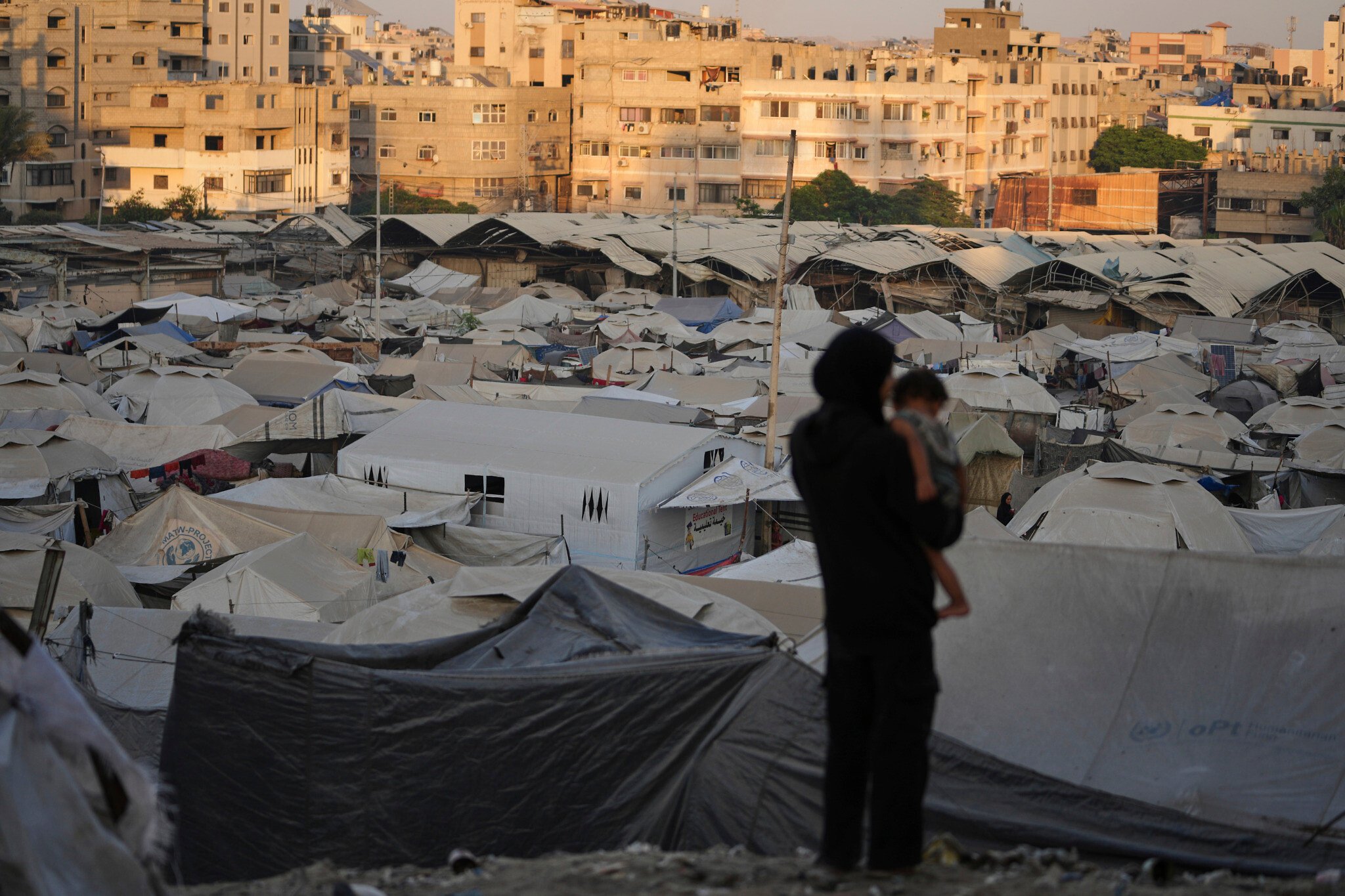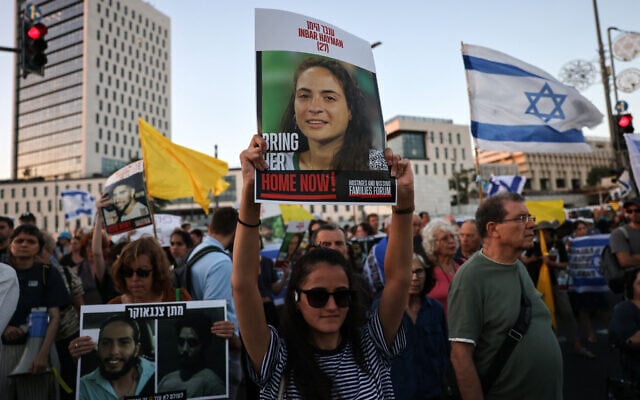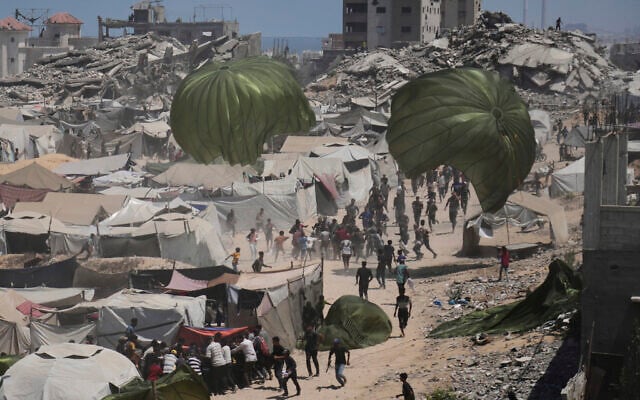Bucking IDF warnings, security cabinet approves Netanyahu plan to conquer Gaza City

The security cabinet approved overnight Thursday-Friday a proposal by Prime Minister Benjamin Netanyahu to take over the densely populated Gaza City, the premier’s office announced in a statement, bucking warnings from the Israel Defense Forces that the operation risks the lives of the remaining hostages in addition to potentially sparking a humanitarian disaster.
The limitation of the takeover to Gaza City did not seem to go as far as what had earlier been characterized as a plan to occupy the entirety of the Strip. Netanyahu told Fox News hours before the security cabinet convened that a full takeover was his intention.
However, the statement from Netanyahu’s office notably described the adopted proposal as one aimed at “defeating Hamas,” meaning that there may be subsequent operations beyond the one for Gaza City that were approved and not announced.
The decision did not use the word “occupy,” and instead referred to “taking over,” due to legal reasons pertaining to Israel’s responsibility for civilian matters in Gaza, according to the Ynet news site. The outlet added, however, citing an unnamed senior Israel official, that this distinction was superficial, and the decision in fact relates to full military rule. The conquest would stop if a hostage deal is clinched, according to the report.
Ministers also endorsed five principles to be fulfilled for the war to end: Hamas’s disarmament, the return of all hostages, Gaza’s demilitarization, ongoing Israeli security control of Gaza, and a post-war civilian government that excludes Hamas and the Palestinian Authority.
Israel says it currently controls 75 percent of the Strip, while the IDF has largely avoided entering the remaining 25% — which mostly comprises Gaza City and refugee camps in central Gaza — due to the belief that most of the hostages are being held there. Almost all of Gaza’s 2 million citizens are currently in the quarter of the Strip that the IDF does not control. Hamas has threatened to execute hostages if its operatives detect Israeli troops closing in; Hamas captors killed six Israeli hostages in Rafah, in southern Gaza, last August, when IDF troops inadvertently neared the tunnel where they were being held.
Some speculated after the cabinet decision was announced whether earlier talk of a larger-scale operation had been a pressure tactic aimed at coaxing Hamas to return to the negotiation table on Israel’s terms.
Roughly 800,000 Palestinians — many of whom have already been displaced several times throughout the 22-month war — currently reside in Gaza City, in northern Gaza. A senior Israeli official told The Times of Israel news that the plan approved by the cabinet will see those civilians evacuated toward the south.
The cabinet decision states that Palestinians will have until October 7, 2025, to evacuate Gaza City — a two-month window that also coincides with the second anniversary of Hamas’s attack on Israel, the Israeli official said.
The IDF will then launch its ground offensive into Gaza City, placing a siege on the area in order to kill any remaining Hamas operatives. After the takeover is complete, the official indicated that the IDF will proceed to the remaining unconquered areas of Gaza.
A security cabinet meeting, in Jerusalem, June 14, 2025. (Avi Ohayon/GPO)
The statement from Netanyahu’s office specified that Israel will provide humanitarian aid to the civilian population outside combat zones.
On Wednesday, US Ambassador to Israel Mike Huckabee said that the controversial US- and Israeli-backed Gaza Humanitarian Foundation will expand its operations from three to 16 distribution sites that will operate 24/7, ostensibly to account for the new evacuation.
The statement from Netanyahu’s office noted that a majority of cabinet members backed a list of five principles that Israel will demand be met before it agrees to end the war with Hamas: (1) The terror group’s disarmament; (2) the return of all 50 remaining hostages — 20 of whom are believed to be alive; (3) the demilitarization of the Gaza Strip; (4) Israeli security control over the Gaza Strip; and (5) the existence of an alternative civilian government that is not Hamas or the Palestinian Authority.

Prime Minister Benjamin Netanyahu speaks to Fox News on August 7, 2025 (Screen Capture)
Netanyahu has long rejected a role for the PA, but the formal adoption of that red line risks leaving Israel alone to govern Gaza after the war, as all Arab countries that have expressed willingness to assist in the rehabilitation effort have conditioned their participation on Ramallah’s involvement.
Nonetheless, Netanyahu claimed in the Fox News interview that after it finishes its takeover of the Strip, Israel will hand over control to “Arab forces.”

Demonstrators raise pictures and flags during an anti-government protest calling for action to secure the release of Israeli hostages, outside the prime minister’s office in Jerusalem on August 7, 2025. (Photo by Ahmad Gharabli / AFP)
During the 10-hour meeting that began at 6 p.m. on Thursday, IDF Chief of Staff Lt. Gen. Eyal Zamir expressed his opposition to Netanyahu’s proposal.
“The lives of the hostages will be in danger if we go ahead with this plan to occupy Gaza. There is no way to guarantee that we will not harm them. Our forces are worn out, the military tools need maintenance, and there are humanitarian and sanitary [concerns regarding the Palestinian population],” Channel 12 quoted the IDF chief as having said.
He explained that a full occupation of the Strip will take a year or two to complete, with the initial phase of intensive fighting likely to last five months.
Netanyahu’s office said in its statement that Zamir presented an alternative plan to the one backed by Netanyahu, but an overwhelming majority of ministers determined that it would not bring about the defeat of Hamas or the release of the hostages
Also during the meeting, members of Israel’s hostage negotiating team urged the ministers not to authorize any plan that would close the possibility for a future deal.
Netanyahu reportedly responded that the Gaza City operation could be stopped at any point if Hamas agrees to Israel’s demands.

In this picture taken from a position on the Israeli border with the Gaza Strip, the sun sets behind destroyed buildings in the Palestinian territory on August 7, 2025. (Jack Guez / AFP)
Far-right National Security Minister Itamar Ben Gvir pushed back on that offer, insisting that Israel must declare that it will not stop the operation until it is complete and that the door to further negotiations with Hamas has been shut.
Hostage families are vehemently opposed to the plan approved by the government, fearing it will lead to their loved ones’ demise, and staged a fiery protest in Tel Aviv on Thursday night. They were joined by thousands of supporters who blocked roads and clashed with police who tried to clear them.
They argue that the last five months have proven that military pressure has not led Hamas to release the hostages and that Israel is in a position to agree to Hamas’s demand to end the war, as the terror group no longer poses a strategic threat to the Jewish state as it did on October 7, 2023.
Hamas has fully transitioned to fighting as a guerrilla group, causing roughly three dozen Israeli casualties since Israel broke the ceasefire in March by launching Operation Gideon’s Chariots, which was also aimed at securing the release of the hostages and defeating Hamas.
Netanyahu argues that ending the war and withdrawing from Gaza, as Hamas demands, will allow Hamas to regroup.
He is also reliant on far-right coalition partners who want to permanently occupy the Strip in order to push Palestinians out of the enclave and re-establish settlements in their place.

Palestinians rush to collect humanitarian aid airdropped by parachutes into Gaza City, northern Gaza Strip, August 7, 2025. (AP/Jehad Alshrafi)
In addition to rejecting a role for the PA, Netanyahu has refused for much of the war to advance a viable alternative to Hamas, which his critics say has allowed the war to drag out endlessly as the terror group has managed to remain the most dominant Palestinian force in Gaza.
For his part, Netanyahu has argued that no alternative to Hamas will be able to survive in Gaza before the terror group has been defeated.
The ongoing war in Gaza started with the Hamas-led October 7, 2023, massacre, in which some 5,600 terrorists invaded Israel, killing 1,200 people, mostly civilians, and taking 251 hostages to the enclave.
The Hamas-run Gaza health ministry says more than 60,000 people in the Strip have been killed or are presumed dead in the fighting so far, though the toll has not been verified and does not differentiate between civilians and fighters. Israel says it has killed some 20,000 combatants in battle as of January and another 1,600 terrorists inside Israel during the October 7 onslaught.
Israel’s toll in the ground offensive against Hamas in Gaza and in military operations along the border with the Strip stands at 459. The toll includes two police officers and three Defense Ministry civilian contractors.

